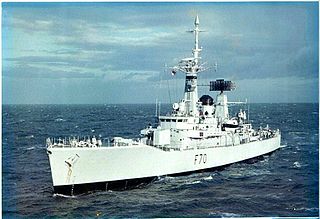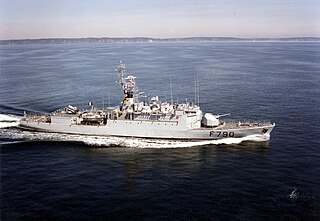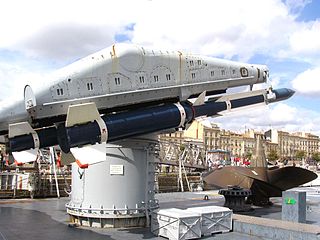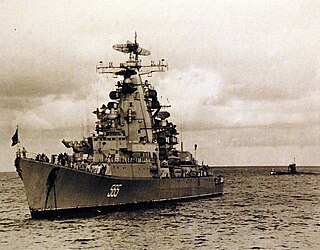
The 46 Knox-class frigates were the largest, last, and most numerous of the US Navy's second-generation anti-submarine warfare (ASW) escorts. Originally laid down as ocean escorts, they were all redesignated as frigates on 30 June 1975, in the 1975 ship reclassification plan and their hull designation changed from 'DE' to 'FF'. The Knox class was the Navy's last destroyer-type design with a steam turbine powerplant.

HMS Apollo was a batch 3B broadbeam Leander-class frigate of the Royal Navy. She was, like the rest of the class, named after a figure of mythology. Apollo was built by Yarrow Shipbuilders of Scotstoun. She was launched on 15 October 1970 and commissioned on 28 May 1972, making her the penultimate Leander.

The La Fayette class is a class of general purpose frigates built by DCNS in the 1980s/90s and still operated by the French Navy today. Derivatives of the type are in service in the navies of Saudi Arabia, Singapore and Taiwan.

The Georges Leygues class was a class of anti-submarine destroyers of the French Navy. They were multi-role ships due to their Exocet and Crotale missile armament, making them especially suitable for the defence of strategic positions, show of force operations, or as high seas escorts. The design was initially officially known as a "corvette" with the designation C70, but were internationally labelled an "anti-submarine destroyer". Subsequently, the French referred to the ships as "frigates" with the designation F70.

The Floréal class is a type of light "surveillance frigates" designed for the needs of the French Navy in low-threat environments ordered in 1989. The ships are named after months of the Republican Calendar. They use construction standards of commercial ships. The frigates were built between 1990 and 1993 by the Chantiers de l'Atlantique at Saint-Nazaire, France. The six French ships of the class, Floréal, Prairial, Nivôse, Ventôse, Vendémiaire and Germinal, remain in active service.

The F67 type, also known as the Tourville class was a class of large high-sea Frigates of the French Navy specialised in anti-submarine warfare. They had anti-air and anti-surface capabilities.

Suffren was a Suffren-class frigate of the French Navy, designed to protect a fleet against air threats, surface ships, submarines, and, to a lesser extent, provide firepower against land objectives. She is the sister ship of Duquesne, and was decommissioned in 2001. She was the seventh French vessel named after the 18th century admiral Pierre André de Suffren.

Duquesne was a Suffren-class frigate of the French Navy. She was designed to protect a fleet against air threats, surface ships, submarines, and, to a lesser extent, provide firepower against land objectives. She is the sister ship of Suffren. She is the eighth French vessel named after the 17th century admiral Abraham Duquesne. Duquesne was decommissioned in 2008.

The D'Estienne d'Orves-class avisos, also known as the A69 type avisos, is a class of avisos, comparable in size to a light corvette, mainly designed for coastal anti-submarine defence, but are also available for high sea escort missions. Built on a simple and robust design, they have an economical and reliable propulsion system which allows them to be used for overseas presence missions. They were initially intended for use by the French Navy, but have been ordered by the South African Navy, Argentinian Navy and Turkish Navy.

The T 47 class or Surcouf class were the first destroyers built for the French Navy after the Second World War. Twelve ships were built between 1955 and 1957. The ships were modernised in the 1960s and decommissioned in the 1980s, when they were replaced by the Cassard and Georges Leygues-class frigates. The class was authorised in 1949 and were designed as aircraft carrier escort vessels. Three were modified to become flagships, four became anti-air guided missile destroyers and five became anti-submarine destroyers. One member of the class survives, Maillé-Brézé as a museum ship at Nantes.

Aconit was a unique frigate built for the French Navy during the Cold War, in commission from 1973 until 1997. She was named after the corvette Aconit which fought in the Free French Naval Forces during World War II.

The Ugra class was the NATO reporting name for a group of seven submarine tenders built for the Soviet Navy in the late 1960s. The Soviet designation was Project 1886. One further ship was built for the Indian Navy to a modified design. The ships were intended to provide afloat support for Soviet submarines, including supplies, water, torpedoes, fuel, and battery charging; minimal repair facilities, and were often employed as flagships/command ships for submarine squadrons. A subclass, the Borodino class, of two ships were constructed for use as training ships and lacked missiles and the ability to support submarines. Instead, the Borodino class had classrooms and training facilities.

The Masurca missile was a first-generation naval surface-to-air missile system developed and used by the French Navy. Planned as the primary air defence missile system of the first generation of French guided missile ships, it was used only aboard the two Suffren-class frigates and as a retrofit to the cruiser Colbert.

Druzhny was a Project 1135 Burevestnik-class Large Anti-Submarine Ship or Krivak-class frigate. Launched on 22 January 1975, the vessel served with the Soviet Navy until it was dissolved and then was transferred to the Russian Navy. After being retired on 10 April 2002, there was an unsuccessful attempt to refit the warship as a shopping and leisure facility, but instead the vessel was scrapped.

Admiral Oktyabrsky was a Project 1134A Berkut A -class cruiser of the Soviet Navy, which briefly became part of the Russian Navy. The sixth ship of her class, the ship served mostly during the Cold War, from 1973 to 1993.

KRI Oswald Siahaan (354) is an Ahmad Yani-class frigate operated by the Indonesian Navy. Prior to her service in the Indonesian Navy, she served in the Royal Netherlands Navy as Van Speijk-class frigateHNLMS Van Nes (F805).

HNLMS Evertsen (F815) was a frigate of the Van Speijk class. The ship was in service with the Royal Netherlands Navy from 1967 to 1989. The ship's radio call sign was "PAVG". She was sold to the Indonesian Navy where the ship was renamed KRI Abdul Halim Perdanakusuma (355).

HNLMS Tjerk Hiddes (F804) was a frigate of the Van Speijk class. The ship was in service with the Royal Netherlands Navy from 1967 to 1986. The ship's radio call sign was "PAVC". She was sold to the Indonesian Navy where the ship was renamed KRI Ahmad Yani (351).

Vladivostok was the second Soviet Navy Project 1134 Admiral Zozulya-class Large Anti-submarine Ship also known as a Kresta I guided missile cruiser. Launched on 1 August 1966, the ship was reclassified a Large Rocket Ship on 3 August 1978 to reflect the wide-ranging capability of the vessel. Serving primarily in the Pacific Fleet during the Cold War, Vladivostok took part in exercises and tours that demonstrated Soviet naval power in the Indian and Pacific Oceans. The ship played a part at a number of points of potential escalation in the Cold War, including the Indo-Pakistani War of December 1971 and the collision between the aircraft carrier Kitty Hawk and the submarine K-314 in March 1984. Vladivostok was taken out of service to be modernised and updated on 28 September 1988 but there were insufficient funds to complete the work. Instead the ship was decommissioned on 19 April 1990 and, the following January, sold to an Australian company to be broken up.

Allal Ben Abdellah (615) is a SIGMA 9813 frigate of the Royal Moroccan Navy. The ship is the last of three SIGMA multi-mission frigates ordered by Morocco from Damen Schelde Naval Shipbuilding, entering service in 2012.





















